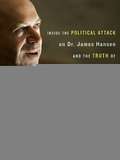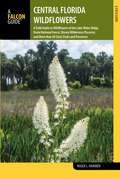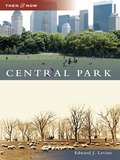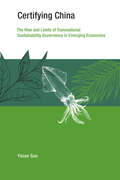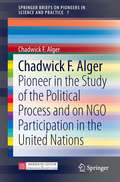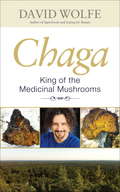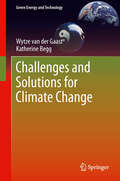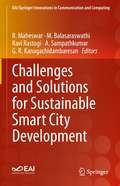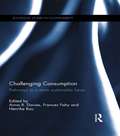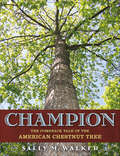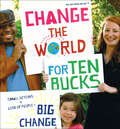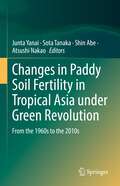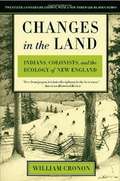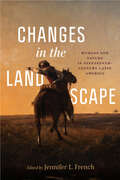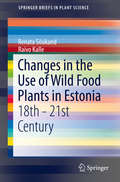- Table View
- List View
Censoring Science
by Mark BowenThe dramatic story of global warming, politics, and the scientist Al Gore calls ?the most powerful and consistent voice calling for intelligent action to preserve our planet?s environment. ? Censoring Science is the gripping story of the world?s preeminent climatologist, Dr. James Hansen, the ?pivotal character in the greatest and most politically charged science story of our time? (New Scientist). NASA?s leading climate expert, Dr. Hansen, first broke the international news on global warming at a Senate hearing in 1988. Little did he expect the rising storm of politically motivated resistance, denial, and obstruction. Revealing the extent of the Bush administration?s censorship of Dr. Hansen?s findings, Censoring Science sets the record straight with solid scientific facts such as: the eight hottest years on record have occurred in the last decade, and ice is melting at record rates all around the planet. Dr. Hansen shows how we can still prevent environmental disaster if the country and the government are willing to face the truth about global warming. .
Central Florida Wildflowers: A Field Guide to Wildflowers of the Lake Wales Ridge, Ocala National Forest, Disney Wilderness Preserve, and More than 60 State Parks and Preserves (Wildflowers in the National Parks Series)
by Roger L. HammerThis guide features stunning color photographs of 300 common wildflowers from Ocala National Forest, Merritt Island National Wildlife Refuge, Loxahatchee National Wildlife Refuge, the Disney Wilderness Preserve, Archbold Biological Station, and Paynes Prairie State Park among others. Detailed descriptions and full-color photos aid the reader in identifying plants in the field.
Central Park
by Edward J. LevineHarper's Weekly reported in 1857 that no engineer had yet been able to present a feasible plan for Central Park and that "it may not ever happen." Their pessimism was misplaced, as Frederick Law Olmsted and Calvert Vaux's Greensward Plan was approved in May 1858. By 1860, visitors were enjoying the magnificent new park's naturalistic splendor. Central Park quickly became one of New York's premier attractions, featuring the menagerie, the mall, Bethesda Fountain, the Metropolitan Museum of Art, the music pavilion, the casino, and the original Croton Reservoir. The northern section of the park was more reminiscent of an untamed wilderness than of an urban park. Through historic postcards, Central Park highlights this man-made green oasis at the center of a teeming metropolis.
Cephalopod Behaviour (2nd Edition)
by Roger T. Hanlon John B. MessengerWith their large brains, elaborate sense organs and complex behaviour, cephalopods are among the world’s most highly evolved invertebrates. This second edition summarises the wealth of exciting new research data stemming from over 500 papers published since the first volume appeared. It adopts a comparative approach to causation, function, development and evolution as it explores cephalopod behaviour in natural habitats and the laboratory. Extensive colour and black-and-white photography illustrates various aspects of cephalopod behaviour to complement the scientific analysis. Covering the major octopus, squid and cuttlefish species as well as the shelled Nautilus, this is an essential resource for undergraduate and advanced students of animal behaviour, as well as researchers new to cephalopods, in fields such as neuroscience and conservation biology. By highlighting the gaps in current knowledge, the text looks to inform and to stimulate further study of these beautiful animals.
Cerebro milenial: Ansiedad, tipos de orientaciones y de identidades sexuales, redes sociales, salud mental y todas las cuestiones existenciales del mundo
by Nacho Roura @NeuronachoUn libro para entender, de una vez por todas y con explicación científica incluida, por qué nos pasa lo que nos pasa a los milenials. «¿Qué es el cerebro milenial?», dices mientras clavas tu pupila en mi perfil de Instagram. Ansiedad, síndrome del impostor, nuevos tipos de amor e identidades, redes sociales... y un montón de cosas son los temas centrales de esta generación marcada por las crisis económicas, la precariedad laboral y los memes virales. Un retrato social actual para entender por qué somos como somos y qué define a la generación milenial desde el punto de vista neurológico y científico. Un libro de divulgación accesible y divertido para finalmente descodificar y entender cómo funciona el cerebro milenial.
Certifying China: The Rise and Limits of Transnational Sustainability Governance in Emerging Economies (Earth System Governance)
by Yixian SunA comprehensive study of the growth, potential, and limits of transnational eco-certification in China and the implications for other emerging economies.China has long prioritized economic growth over environmental protection. But in recent years, the country has become a global leader in the fight to save the planet by promoting clean energy, cutting air and water pollution, and developing a system of green finance. In Certifying China, Yixian Sun explores the potential and limits of transnational eco-certification in moving the world&’s most populous country toward sustainable consumption and production. He identifies the forces that drive companies from three sectors—seafood, palm oil, and tea—to embrace eco-certification. The success of eco-certification, he says, will depend on the extent to which it wins the support of domestic actors in fast-growing emerging economies. The assumption of eco-certification is that demand along the supply chain can drive businesses to adopt good practices for social, environmental, and economic sustainability by specifying rules for production, third-party verification, and product labeling. Through case studies drawn from extensive fieldwork and mixed methods, Sun traces the processes by which certification programs originating from the Global North were introduced in China and gradually gained traction. He finds that the rise of eco-certification in the Chinese market is mainly driven by state actors, including government-sponsored industry associations, who seek benefits of transnational governance for their own development goals. The book challenges the conventional wisdom that the Chinese state has little interest in supporting transnational governance, offering novel insights into the interaction between state and non-state actors in earth system governance in emerging economies.
Chacra 51: Regreso a la Patagonia en los tiempos del fracking
by Maristella SvampaHistoria a la vez familiar y social, vinculada al avance del fracking en Allen, Río Negro, sobre las tierras que los inmigrantes habían transformado al plantar peras y manzanas. En 2011, en la chacra del abuelo de la autora -conocida militante social y ambientalista- asoma una torre de petróleo. Una historia familiar que mezcla la literatura, la sociología y la filosofía con la militancia socioambiental. Cuando don Alfredo vio que una torre asomaba por entre los álamos, se preguntó con sorpresa: "¿Qué hace eso tan cerca del pueblo?". Nadie se había animado a decirle que los administradores de esas tierras -parte de su familia- habían firmado un contrato con una empresa norteamericana para instalar, entre los perales y manzanos de la chacra que había sido de su padre, una plataforma de explotación de hidrocarburos. Eso sucedió en 2011, y a partir de entonces las plantaciones de frutales empezaron a ser desmontadas, y los pozos de extracción de petróleo y de gas proliferaron en Allen, en el corazón del Alto Valle de Río Negro. De manera asordinada pero vertiginosa, esa localidad se convirtió, junto con Vaca Muerta, en cabecera de playa del fracking en la Argentina. Don Alfredo es el padre de Maristella Svampa, que nació en esas tierras y que, de pronto, vio cómo su familia, la comunidad donde se crió y sus actividades de reconocida militante socioambiental en el país y el exterior se entrelazaban en un doloroso y acuciante primer plano. Chacra 51 es la narración íntima de esa experiencia, pero también, y sobre todo, es un llamado urgente a enfrentar el avance de una actividad que, detrás del proclamado "progreso", impone daños irreversibles en un planeta castigado y en la vida que sostiene.
Chadwick F. Alger: Peace Research and Peacebuilding (SpringerBriefs on Pioneers in Science and Practice #9)
by Chadwick F AlgerThis is the third volume to commemorate the 90th birthday of the distinguished scholar Chadwick F. Alger to honor his lifetime achievement in international relations, as President of the International Studies Association (1978-1979) and as Secretary General of the International Peace Research Association (1984-1987). After a brief introduction by Chad F. Alger this volume presents six of his key texts on Peace Research and Peacebuilding, covering "The quest for peace: What are we learning?"; "The Emerging Toolchest for Peacebuilders"; "Peace Studies as a Transdisciplinary Project"; "Challenges for Peace Researchers and Peace Builders in the Twenty-First Century: Education and Coordination of a Diversity of Actors in Applying What We Are Learning"; "The escalating peace potential of global governance", "There Are Peacebuilding Tasks for Everybody", and "What Should Be the Foundations of Peace Education?"
Chadwick F. Alger: Pioneer in the Study of the Political Process and on NGO Participation in the United Nations (SpringerBriefs on Pioneers in Science and Practice #7)
by Chadwick F AlgerThis volume honors the lifetime achievements of distinguished scholar Chadwick F. Alger on the occasion of his 90th birthday. Carolyn Stephenson presents Prof. Alger as a Pioneer in the Study of the Political Process and on NGO Participation in the United Nations. Part 1 offers an autobiographical note and a comprehensive bibliography of his academic publications. Part II includes three texts on "The Political Process in the UN," namely "The Researcher in the United Nations: Evolution of a Research Strategy," "Interaction in a Committee of the United Nations General Assembly" and "Interaction and Negotiation in a Committee of the UN GA." In Part III, which focuses on "Civil Society Organizations in the UN System (NGOs)," three chapters deal with "Evolving Roles of NGOs in Member State Decision-making in the UN System," "The Roles of NGOs in the UN System: From Article 71 to a People's Millennium Assembly" and "Strengthening relations between NGOs and the UN system: Towards a research agenda."
Chaga
by David Wolfe Ramiz Saad Pierre BeaumierTaking the counsel of Hippocrates--"Let food be thy medicine and medicine be thy food"--acclaimed author David Wolfe brings the wisdom of eating herbal medicine to today's health-conscious readers. His enthusiastic fan base, which includes celebrities such as Woody Harrelson and Angela Bassett, continues to blossom as more and more people realize the healing and immunity-boosting properties of raw and medicinal foods. In Chaga, Wolfe presents the many virtues of medicinal mushrooms, which boost immunity, stave off allergies and asthma, help fight against cancer, and generally improve core vitality. But the star of the book is chaga--"the king of the mushrooms"--which holds the greatest storehouse of medicinal properties of any mushroom species. In addition to exploring the extraordinary history, lore, scientific research, and future of this potent healing mushroom, Wolfe provides readers with recipes for teas, soups, fermentations, and tinctures--as well as tips on how to obtain quality chaga products. Other mushrooms are also discussed, such as the fabled queen of the medicinal mushrooms, reishi--which promotes a healthy immune system--and the cordyceps--which fights fatigue, improves endurance, increases lung capacity, and more. The wealth of wisdom, research, recipes, and advice will enlighten and satisfy Wolfe's fans, as well as any reader curious about natural ways to improve health and promote healing.From the Trade Paperback edition.
Chaga
by David Wolfe Ramiz Saad Pierre BeaumierTaking the counsel of Hippocrates--"Let food be thy medicine and medicine be thy food"--acclaimed author David Wolfe brings the wisdom of eating herbal medicine to today's health-conscious readers. His enthusiastic fan base, which includes celebrities such as Woody Harrelson and Angela Bassett, continues to blossom as more and more people realize the healing and immunity-boosting properties of raw and medicinal foods. In Chaga, Wolfe presents the many virtues of medicinal mushrooms, which boost immunity, stave off allergies and asthma, help fight against cancer, and generally improve core vitality. But the star of the book is chaga--"the king of the mushrooms"--which holds the greatest storehouse of medicinal properties of any mushroom species. In addition to exploring the extraordinary history, lore, scientific research, and future of this potent healing mushroom, Wolfe provides readers with recipes for teas, soups, fermentations, and tinctures--as well as tips on how to obtain quality chaga products. Other mushrooms are also discussed, such as the fabled queen of the medicinal mushrooms, reishi--which promotes a healthy immune system--and the cordyceps--which fights fatigue, improves endurance, increases lung capacity, and more. The wealth of wisdom, research, recipes, and advice will enlighten and satisfy Wolfe's fans, as well as any reader curious about natural ways to improve health and promote healing.
Challenges and Solutions for Climate Change (Green Energy and Technology)
by Katherine Begg Wytze Van GaastThe latest scientific knowledge on climate change indicates that higher greenhouse gas concentrations in the atmosphere through unchecked emissions will provoke severe climate change and ocean acidification. Both impacts can fundamentally alter environmental structures on which humanity relies and have serious consequences for the food chain among others. Climate change therefore poses major socio-economic, technical and environmental challenges which will have serious impacts on countries' pathways towards sustainable development. As a result, climate change and sustainable development have increasingly become interlinked. A changing climate makes achieving Millennium Development Goals more difficult and expensive, so there is every reason to achieve development goals with low greenhouse gas emissions. This leads to the following five challenges discussed by Challenges and Solutions for Climate Change: 1. To place climate negotiations in the wider context of sustainability, equity and social change so that development benefits can be maximised at the same time as decreasing greenhouse gas emissions. 2. To select technologies or measures for climate change mitigation and adaptation based on countries' sustainable development and climate goals. 3. To create low greenhouse gas emission and climate resilient strategies and action plans in order to accelerate innovation needed for achieving sustainable development and climate goals on the scale and timescale required within countries. 4. To rationalize the current directions in international climate policy making in order to provide coherent and efficient support to developing countries in devising and implementing strategies and action plans for low emission technology transfers to deliver climate and sustainable development goals. 5. To facilitate development of an international framework for financial resources in order to support technology development and transfer, improve enabling environments for innovation, address equity issues such as poor people's energy access, and make implementation of activities possible at the desired scale within the country. The solutions presented in Challenges and Solutions for Climate Change show how ambitious measures can be undertaken which are fully in line with domestic interests, both in developing and in developed countries, and how these measures can be supported through the international mechanisms.
Challenges and Solutions for Sustainable Smart City Development (EAI/Springer Innovations in Communication and Computing)
by R. Maheswar G. R. Kanagachidambaresan M. Balasaraswathi Ravi Rastogi A. SampathkumarThis book discusses advances in smart and sustainable development of smart environments. The authors discuss the challenges faced in developing sustainable smart applications and provide potential solutions. The solutions are aimed at improving reliability and security with the goal of affordability, safety, and durability. Topics include health care applications, sustainable smart transportation systems, intelligent sustainable wearable electronics, and sustainable smart building and alert systems. Authors are from both industry and academia and present research from around the world.Addresses problems and solutions for sustainable development of smart cities;Includes applications such as healthcare, transportation, wearables, security, and more;Relevant for scientist and researchers working on real time smart city development.
Challenges in Higher Education for Sustainability (Management and Industrial Engineering)
by J. Paulo Davim Walter Leal FilhoThis book presents the latest advances on the incorporation of sustainability in higher education. Different aspects such as the environmental, economic and social are here discussed. Several examples illustrating how sustainability in higher education is being pursued in different countries can be found in this book. Case studies include institutions from Kosovo, Brazil, Portugal, UK, Canada and USA.
Challenging Consumption: Pathways to a more Sustainable Future (Routledge Studies in Sustainability)
by Frances Fahy Henrike Rau Anna R. DaviesSustainable consumption is a central research topic in academic discourses of sustainable development and global environmental change. Informed by a number of disciplinary perspectives, this book is structured around four key themes in sustainable consumption research: Living, Moving, Dwelling and Futures. The collection successfully balances theoretical insights with grounded case studies, on mobility, heating, washing and eating practices, and concludes by exploring future sustainable consumption research pathways and policy recommendations. Theoretical frameworks are advanced throughout the volume, especially in relation to social practice theory, theories of behavioural change and innovative visioning and backcasting methodologies. This groundbreaking book draws on some conceptual approaches which move beyond the responsibility of the individual consumer to take into account wider social, economic and political structures and processes in order to highlight both possibilities for and challenges to sustainable consumption. This approach enables students and policy-makers alike to easily recognise the applicability of social science theories.
Champion: The Comeback Tale of the American Chestnut Tree
by Sally M. WalkerAmerican chestnut trees were once found far and wide in North America's eastern forests. They towered up to one hundred feet tall, providing food and shelter for people and animals alike. For many, life without the chestnut seemed unimaginable—until disaster struck in the early 1900s.What began as a wound in the bark of a few trees soon turned to an unstoppable killing force. An unknown blight was wiping out the American chestnut, and scientists felt powerless to prevent it. But the story doesn't end there. Today, the American chestnut is making a comeback. Narrative nonfiction master Sally M. Walker tells a tale of loss, restoration, and the triumph of human ingenuity in this beautifully photographed middle-grade book.
Chance and Change: Ecology for Conservationists
by William Holland Drury Jr.The result of a lifetime in the field and in the classroom, Chance and Change challenges many of the tenets of establishment ecology. Charging that most of the environmental movement has ignored or rejected the changes in thinking that have infiltrated ecological theory since the mid 70s, William Drury presents a convincing case that disorder is what makes the natural world work, and that clinging to romantic notions of nature's grand design only saps the strength of the conservation movement. Drury's training in botany, geology, and zoology as well as his life-long devotion to work in the field gave him a depth and range of knowledge that few ecologists possess. This book opens our eyes to a new way of looking at the environment and forces us to think more deeply about nature and our role in it.Chance and Change is intended for the serious amateur naturalist or professional conservationist. Drury argues that chance and change are the rule, that the future is as unpredictable to other organisms as it is to us, and that natural disturbance is too frequent for equilibrium models to be useful. He stresses the centrality of natural selection in explaining the meaning of biology and insists the book and the laboratory must be checked at all times against the real world. Written in an easy, personal style, Drury's narrative comes alive with the landscape—the salt marshes, dunes, seashores, and forests—that he believed served as the best classroom. His novel approach of correlating landscape evolution with ecological principles offers a welcome corrective to discordance between what we observe in nature and what theory tells us we should see.
Change Starts with Us
by Sophie BeerThis vibrant board book by the creator of Love Makes a Family and Kindness Makes Us Strong celebrates small acts of green living that make a big impact on the environment.Change starts with planting trees. It starts with turning off faucets, and reusing and recycling. Most importantly, change starts with us! This encouraging preschool read-aloud demonstrates simple yet mighty examples of environmental activism and ways in which young readers can take care of the earth. Whether it's biking places with family or picking up litter with friends, Change Starts with Us proves that everyone has the power to build a better world.
Change the World for Ten Bucks: Small Actions X Lots Of People = Big Change
by We Are What We DoFifty simple actions we can all do to make the world a better place—from talking to the young and elderly to ending the use of plastic bags. In 2004, a London-based community organization called We Are What We Do launched with the publication of a little book with a big idea: fifty simple actions to make the world a better place. Since then, Change the World for Ten Bucks has spawned a movement, multiple editions, and sales of over one million copies internationally. At last, here&’s the US edition. Change the World for Ten Bucks delights and engages at every turn. It also includes dozens of creative prompts for positive change
Changes in Paddy Soil Fertility in Tropical Asia under Green Revolution: From the 1960s to the 2010s
by Junta Yanai Sota Tanaka Shin Abe Atsushi NakaoThis book investigates the effect of the Green Revolution (GR) on long-term changes in the fertility status of paddy soils in tropical Asia. While information on long-term changes in soil fertility status are rather limited due to difficulties in obtaining past data or samples for comparison, this investigation on temporal changes in soil fertility is possible by comparing fertility status in the 2010s, which the authors examined recently, with those from the 1960s, when GR was initiated, which was reported by Kawaguchi & Kyuma (1977). More than 220 paddy soils collected from Thailand, the Philippines, Malaysia, Bangladesh, and Indonesia were analyzed for their physicochemical properties as well as total and available fractions of plant macro- and micro- essential elements, and their temporal changes were examined in addition to their spatial variation in each country. The most significant change was a drastic increase of available phosphorus in soils, possibly due to fertilization after the GR. Changes in organic matter, pH, and other nutrients were relatively small. A considerable decrease in the content of some micronutrients was also observed. Long-term studies on soil fertility status in the past and present will be useful to establish soil/fertilizer management for sustainable rice production in the future. This book is an essential reading for soil scientists, agricultural scientists, environmental scientists, as well as policymakers and nongovernmental officers such as FAO.
Changes in the Land: Indians, Colonists, and the Ecology of New England
by John Demos William CrononThe book that launched environmental history now updated. Winner of the Francis Parkman Prize In this landmark work of environmental history, William Cronon offers an original and profound explanation of the effects European colonists' sense of property and their pursuit of capitalism had upon the ecosystems of New England. Reissued here with an updated afterword by the author and a new preface by the distinguished colonialist John Demos,Changes in the Land, provides a brilliant inter-disciplinary interpretation of how land and people influence one another. With its chilling closing line, "The people of plenty were a people of waste," Cronon's enduring and thought-provoking book is ethno-ecological history at its best.
Changes in the Landscape: Humans and Nature in Nineteenth-Century Latin America
by Stephanie NiuChanges in the Landscape is a collection of timely essays that bring the methodologies and commitments of ecocriticism to bear on the study of Latin American literature and cultural production. The book&’s eleven chapters, written by some of the leading voices in the field, invite readers to consider how the relationship between humans and nonhuman nature was fundamentally transformed during a period when new modes of capitalist production were emerging in the region and around the world. Jennifer L. French&’s introductory essay provides a historical and theoretical framework for the collection. Ranging from the immediate aftermath of the Spanish‑American Wars of Independence (1810–1826) to the early twentieth century (1925), the volume&’s essays cover a wide variety of genres and forms of cultural production, from José Hernández&’s epic poem Martín Fierro to prose fiction, painting and photography, and the personal albums compiled by Spanish-American women. Individually and collectively, the essays engage with scientific writing as both a discourse of power and a source of potentially significant, even revelatory information about human and nonhuman nature. Changes in the Landscape enables readers to more fully understand the transition from colonial regimes to the ecocidal extractivism of the export boom (1870–1930) by drawing out and analyzing some of the cognitive resources and rhetorical strategies that were available to imagine, protest, or enact new norms and expectations regarding the relations between human and nonhuman life, be it the life of wildflowers, waterfalls, or Cuba&’s Ciénaga de Zapata.
Changes in the Use of Wild Food Plants in Estonia: 18th - 21st Century (SpringerBriefs in Plant Science)
by Renata Sõukand Raivo KalleThis book is a systematized overview of wild edible plants eaten in the territory of present Estonia, with a focus on the systematic changes within the field. Starting in the end of 18th century, when the first data was published, the text is an extended version and compilation of articles on the subject published by Drs. Kalle and S#65533;ukand and includes unpublished fieldwork results. This work covers changes and tendencies not covered previously due to the limits of article length. Included in this data is a general overview table containing all used plant taxa, parts used and purposes of use. More details on specific food-uses are provided in separate chapters analysing dynamics of changes of the importance of wild plants within the specific food category.
Changing Climate Politics: U.S. Policies and Civic Action
by Yael Wolinsky-NahmiasChanging Climate Politics provides a comprehensive account of the current state of government action and political participation in the United States on the issue of climate change. The book evaluates the role of the federal government, the courts, states, and cities in tackling the problems created by climate change, offering an inclusive and balanced assessment of progress and challenges. The book further explores the growing role of civic society in climate action plans, analyzing public opinion, the U.S. climate movement, policy making through ballot measures, consumer action, and the prospect of a social transformation toward a more sustainable society. This timely volume examines new approaches to policies and civic action on climate change addressing critical questions about the responsibilities and obligations of governments and citizens.
Changing Climate Politics: U.S. Policies and Civic Action
by Yael Wolinsky-NahmiasChanging Climate Politics provides a comprehensive account of the current state of government action and political participation in the United States on the issue of climate change. The book evaluates the role of the federal government, the courts, states, and cities in tackling the problems created by climate change, offering an inclusive and balanced assessment of progress and challenges. The book further explores the growing role of civic society in climate action plans, analyzing public opinion, the U.S. climate movement, policy making through ballot measures, consumer action, and the prospect of a social transformation toward a more sustainable society. This timely volume examines new approaches to policies and civic action on climate change addressing critical questions about the responsibilities and obligations of governments and citizens.
